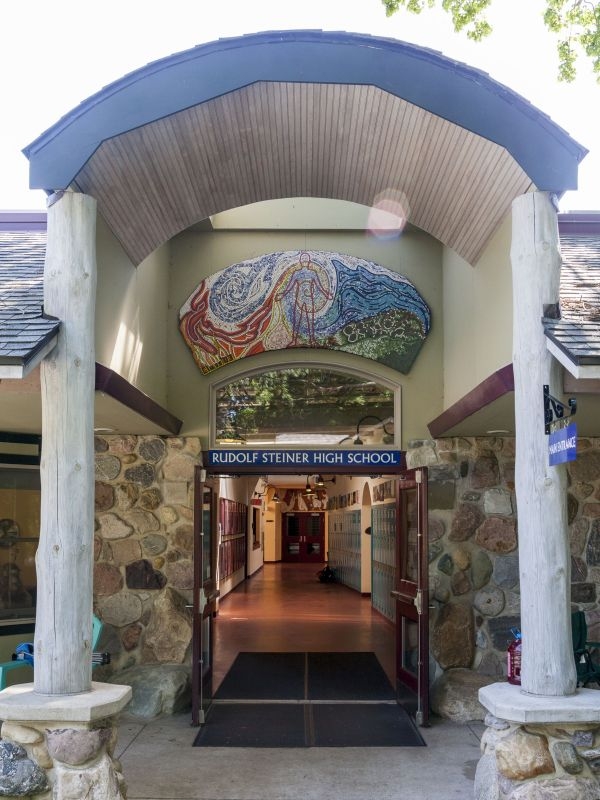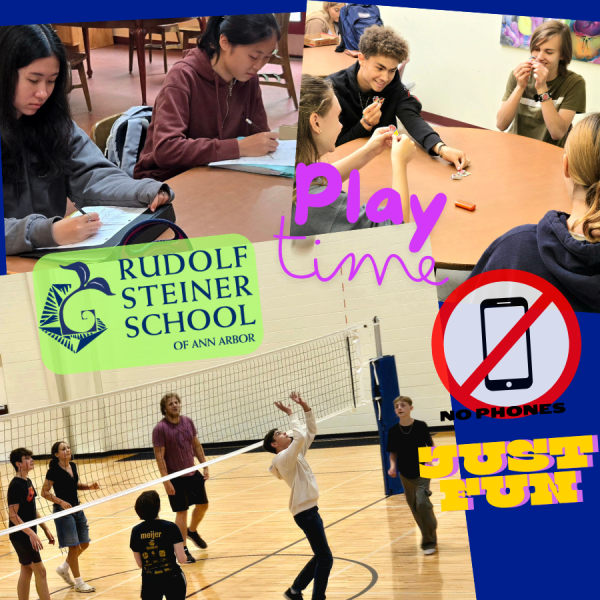

Waldorf Graduates Pursue Meaningful Careers

Will My Child Succeed After Waldorf High School? The Research Says Yes
Choosing a high school is a critical decision, and parents often wonder: Will this education prepare my child for college, career, and life?
For families considering Waldorf high schools, this question is especially relevant. With experiential learning, seminar-style discussions, and an interdisciplinary curriculum, can Waldorf truly equip students for fields like medicine, law, technology, and business?
Decades of research say yes.
Waldorf Graduates Excel in Higher Education and Careers
A 60-year study (Survey of Waldorf Graduates, Phase II, Mitchell & Gerwin, 2007) found that:
- 94% of Waldorf graduates attend college.
- 42% major in science-related fields—more than double the national average.
- Many earn advanced degrees in medicine, law, engineering, business, and the arts.
- Alumni thrive in fields ranging from finance and research to entrepreneurship and sustainability.
Waldorf Alumni Spotlight: Science in Action
After earning a degree in Earth Systems Engineering from the University of Michigan, Gavin Chensue ('06) joined the NOAA Commissioned Officer Corps, leading critical climate studies worldwide.
"Steiner education gave me a taste of everything. When I needed direction in college, I remembered how much I loved studying weather and geology—and that led me to where I am today." - Gavin Chensue (RSSAA '06), Research Engineer at SRI International, Former NOAA Corps Officer
His story highlights how Waldorf graduates succeed in STEM, combining curiosity and real-world problem-solving to make a global impact.
Read the full studies:
- Survey of Waldorf Graduates, Phase II: https://www.waldorfeducation.org/research
- Into the World Study: https://www.waldorfeducation.org/graduate-outcomes
What Makes a Waldorf Education So Effective?
Contrary to the belief that test-driven education leads to success, research shows that employers and universities highly value graduates who:
✔ Think critically and independently
✔ Communicate clearly and persuasively
✔ Collaborate effectively
✔ Solve complex problems
✔ Adapt to a changing world
These are precisely the skills Waldorf high schools cultivate.
1. Depth Over Memorization: Lifelong Knowledge Retention
Rather than rote memorization, Waldorf fosters deep understanding:
- History is explored through primary sources and narratives.
- Science emphasizes hands-on experiments and independent research.
- Mathematics focuses on real-world application.
- Literature and philosophy encourage analytical discussions.
One employer noted:
“Waldorf students don’t just look for the right answer—they explore the why and how behind complex issues.”
2. Seminar-Style Learning Develops Exceptional Communicators
Waldorf emphasizes oral presentations, debates, and collaborative discussions, preparing graduates for leadership roles in law, finance, business, and medicine.
Dr. Ilan Safit, co-author of *Into the World*, states:
“We consistently hear that Waldorf graduates excel at teamwork and leadership. Their ability to articulate complex ideas is a major asset.”
A study from Da Vinci Waldorf School found that Waldorf students select careers based on values and passion rather than prestige or income.
Final Thoughts: The Research Speaks for Itself
Professors and employers highlight Waldorf graduates’ intellectual curiosity and ability to think independently.
With strong college attendance rates, success across multiple professions, and the skills needed to navigate a complex world, one thing is clear:
Waldorf graduates don’t just succeed—they thrive.
Professors and employers highlight Waldorf graduates’ intellectual curiosity and ability to think independently.
With strong college attendance rates, success across multiple professions, and the skills needed to navigate a complex world, one thing is clear:
Waldorf graduates don’t just succeed—they thrive.
Read more on Waldorf Graduates
Selecting a High School

Selecting a High School
Advice from Veteran Waldorf Educators
Choosing the right high school can feel like one of the most significant decisions a family will make in their child’s educational journey.
To bring clarity to this decision, we turned to two of our most experienced educators at the Rudolf Steiner School of Ann Arbor: Margot Amrine, a longtime Waldorf teacher with over four decades of experience, and Dr. Siân Owen-Cruise, our former School Administrator, who has guided countless families through the high school selection process.
Today’s parents listen to and respect their children’s perspectives more than ever before- a positive shift in family dynamics. But as Margot reminds us, that doesn’t mean parents should surrender their leadership on big decisions.
“In our family we said that Waldorf Education for 9th and 10th grade was essential. At 11th grade, a different kind of maturity sets in; if our children had made compelling reasons to leave then, we would have considered. We never had these discussions!”
Dr. Owen-Cruise expands on this, acknowledging that social pressures play an outside role in an 8th Grader's thinking:
“It's natural for teenagers to focus on their peers and social dynamics when thinking about high school. As parents, we listen, we understand, and we take their feelings seriously- but ultimately, we need to lead this decision with wisdom and foresight.”
Dr. Owen-Cruise often frames the conversation with the rising student in the following way:
“Your parents will choose where you receive your high school education, with your input. YOU will choose where you go to college, with our parental input.”
Many families who have walked this path find that their children- whether they started in Waldorf Education or joined from another school-ultimately express gratitude that their parents guided this decision with their long-term development in mind.
Here are some other helpful tips and information when thinking about our own High School:
Waldorf Graduates Pursue Meaningful Careers
“Will My Child Succeed After Waldorf High School? The Research Says Yes” - Blog Article
Parents often ask: Does a Waldorf education prepare students for college, careers, and beyond? The answer is a resounding yes. Studies show that Waldorf graduates not only attend college at high rates but also excel in fields like science, medicine, law, and technology. Employers and universities consistently praise their ability to think critically, communicate effectively, and adapt to a changing world. Want to know why? This article dives into the research and real-world successes of our alumni.
The Joy of a Phone-Free School: How Our Students Thrive Without Screens
"The Joy of a Phone-Free School: How Our Students Thrive Without Screens" - Blog Article
In an age where screens dominate every aspect of life, imagine a school where students engage in real conversations, dive into hands-on projects, and focus fully in class—without the pull of notifications. Our phone-free policy isn’t just a rule; it’s a game-changer. See how it shapes our students’ social and academic lives!
The Joy of a Phone-Free School: How Our Students Thrive Without Screens

The Joy of a Phone-Free School: How Our Students Thrive Without Screens
Imagine a typical school day where students, between classes and during breaks, are glued to their smartphones—scrolling through social media, playing games, or texting. Conversations are sparse, eye contact is minimal, and the vibrant energy of youthful interaction seems subdued. Now, contrast this with a school environment where smartphones are set aside: students engage in lively face-to-face discussions, participate in spontaneous games, and immerse themselves fully in classroom activities without the constant pull of notifications. This is the reality we’ve cultivated at Rudolf Steiner School of Ann Arbor, embracing a phone-free policy that fosters genuine connections and holistic development.
The Deeper Engagement of Phone-Free Education
At our school, we’ve observed that removing smartphones from the school day does more than just eliminate distractions—it rekindles a deeper, more meaningful engagement among students. Freed from screens, students rediscover the joy of direct communication, collaborative problem-solving, and hands-on learning. This environment aligns seamlessly with the principles of Waldorf education, emphasizing experiential learning and nurturing the whole child.
We Are Phone-Free, Not Tech-Free
While our school maintains a phone-free environment during school hours, we are not devoid of technology. In fact, our curriculum incorporates technology in age-appropriate ways to ensure students are prepared for the digital world:
• Middle School: Students are introduced to computers and the internet in an intentional way that supports learning. Additionally, our middle school robotics club fosters interest in technology and engineering through hands-on projects. https://www.steinerschool.org/programs/extracurricular-activities.cfm
• High School: Our state-of-the-art computer lab facilitates courses in coding, digital literacy, and other computer science subjects. We also have an active high school robotics club where students collaborate on competitive projects that develop real-world problem-solving skills. https://www.steinerschool.org/about-us/waldorf-education.cfm
Many of our graduates go on to thrive in technology fields, excelling in computer science, engineering, and data analysis. Research shows that Waldorf graduates develop strong interdisciplinary thinking skills that prepare them for success in fields that require both creativity and technical expertise.
Leading the Way in Ann Arbor
Our commitment to a phone-free school day positions us as pioneers in the Ann Arbor educational community. While some other local schools have implemented partial restrictions, our comprehensive approach ensures that students remain unplugged throughout the day—including breaks and transitions between classes.
Several Ann Arbor schools are recognizing the value of limiting phone use:
• Forsythe Middle School and Tappan Middle School both require students to keep phones in lockers during school hours. https://forsythe.a2schools.org/our-school/cell-phone-policy, https://tappan.a2schools.org/our-school/cell-phone-policy
• Huron High School has introduced classroom phone storage policies in its Mathematics and English departments to help students stay focused. https://thehuronemery.com/9731/news/cell-phone-use-teacher-led-procedures-to-enrich-student-experience/
The Transformative Power of Disconnecting
The shift to a phone-free environment has yielded profound benefits:
• Enhanced Academic Focus: Without the allure of smartphones, students engage more deeply in lessons, leading to improved comprehension and retention.
• Strengthened Social Bonds: Face-to-face interactions during breaks and collaborative projects foster authentic relationships and empathy among students.
• Improved Mental Well-being: Reducing screen time has been linked to decreased anxiety and stress, allowing students to be more present and mindful.
Embracing a Connected Future Without Phones
As more schools recognize the value of limiting smartphone use, it’s evident that this movement is not about restricting technology but about reclaiming the essence of human connection and focused learning. By leading the way in this initiative, Rudolf Steiner School of Ann Arbor not only adheres to the foundational principles of Waldorf education but also prepares students for careers in STEM, the arts, and beyond.
We invite families seeking a nurturing, distraction-free educational environment to join us in this journey, where students can truly engage with the world around them and develop into well-rounded individuals.
Explore the experiences of other schools with phone-free policies:
• “New data reveals shocking trend since school mobile phone ban”
- “The big smartphone school experiment”
https://www.thetimes.co.uk/article/inside-schools-ban-smartphones-6knb8qtfc
- “Cell phones hinder classroom learning. Texas should tell school districts to lock them up”
- "Waldorf Schools are Media Literacy Role Models"
https://www.steinerschool.org/about-us/waldorf-schools-are-media-literacy-role-models/
An Unhurried Childhood
A recent New York Times article highlighted the importance of giving children an unhurried childhood, without an overpacked schedule of extracurricular activities and excessive homework. The pressure on Gen Z to excel at a young age has led to decreased mental health and increasing struggles at school. Waldorf Education takes a balanced approach, with plenty of time for children to play and explore, while also providing a joyful and well-rounded education that instills essential life skills, sparks a lifelong love of learning, and prepares them for a successful future.
This article was written by Shalini Shankar and originally published on July 9, 2021 in the New York Times
A Packed Schedule Doesn’t Really ‘Enrich’ Your Child
When the extracurricular-industrial complex came to a grinding halt last spring, parents were left scrambling to fill vast hours of unscheduled time. Some activities moved to remote instruction but most were canceled, and keeping children engaged became the bane of parents’ existence. Understandably, screens became default child care for younger kids and social lifelines for older ones.
As American society reopens, going back to our children’s prepandemic activities looks like an enticing way to reintroduce upper-elementary through high-school-age kids to the outside world. For parents with economic means, it’s tempting to return to a full slate of language classes, sports, music lessons and other extracurriculars — a guilt-free plan to keep kids busy with “enriching” activities while we get our jobs done.
But I suggest pausing before filling up their calendars again. We should not simply return children to their hectic prepandemic schedules.
Certainly, some amount of extracurricular activity can offer a welcome break from screens and help children nurture interests. But for Generation Z, the over-scheduling of extracurricular activities has been bad for stress and mental health and even worse for widening racial gaps. Moreover, as I learned when I conducted anthropological research for my book “Beeline: What Spelling Bees Reveal About Generation Z’s New Path to Success,” it no longer consistently improves the prospects of the white middle-class kids for whom it was designed.
But what can parents do with our kids instead? The answer is simple, though not easy to carry out: We can teach them (and perhaps relearn ourselves) the value of unstructured time and greater civic participation.
This does not mean we should quit our day jobs and devote ourselves instead to endless hours of building forts and playing games. Exposing children to sports, music, art, programming or dance certainly has benefits — including physical exercise, intellectual stimulation and fun — but there are also good reasons to give children time to be bored. Not least of these is it forces them to figure out a way to entertain themselves.
For many kids today, scheduled time and down time on their screens are the only states of being. Paradoxically, scheduled unstructured time could address this. Cooking, reading a book, art projects and neighborhood walks are unlikely to completely replace screens, but routinizing blocks of time for these self-sustaining activities each day or several times a week could introduce children and teenagers to new pleasures, and at the very least invite calmness.
Gen Z acutely feels the pressure to be accomplished at a younger age. As kids take on a wider range of challenging activities younger, a trend that began with millennials but has grown to steroidal levels, the criteria for standing out in the college admissions process have shot up accordingly. It’s no wonder kids are stressed out.
The Slacker Generation, an initially disparaging label that Gen Xers have reclaimed, did not have to build a childhood résumé brimming with skills, expertise and accolades to get into college. Now many of these former slackers are parents worried about whether their kids are doing enough to stay competitive in college admissions and the job market. Those who can afford it feel pressure to pad their kids’ résumés as much as they can. A 2019 survey found that more than a quarter of “sports parents” spent upward of $500 per month, with some spending over $1,000 and jeopardizing their retirement savings.
But it’s clear by now that all this expensive enrichment won’t ensure kids’ success. Despite middle- and upper-class millennials mortgaging their childhood to get into college and then toiling through early adulthood in unpaid internships, they are unable to acquire the levels of economic and social security still held by their baby boomer parents.
Perhaps that’s why Gen Z has shown astute awareness of the dangers of overwork, with some high-profile Zoomers demonstrating acts of radical self-preservation. The Gen Z tennis star Naomi Osaka, for example, recently chose to prioritize her well-being over her career’s demands when she dropped out of the French Open after officials fined her for declining to participate in its post-match news conferences. Gen Z seems to have accepted that no matter how much you love your job, your job won’t love you back. Their parents — Gen Xers and even older millennials — were late to this lesson, and if they learned it at all, it was often only when they hit a wall with burnout.
Of course, preparing children for college and the job market is not the only goal of parents shelling out for guitar lessons or robot-making labs. Parents are also eager to expose their children to different ways of using their minds and bodies in the hope that they’ll discover passions that could become vocations, or simply lifelong joys. One passion that’s worth trying to instill is civic participation.
As parents, we can reinforce the importance of caring beyond one’s own success. Taking your kids to volunteer or to protest injustices they see in the world are good ways to show them what it looks like to give back and replenish. The human and nonhuman connections they will make at food pantries and animal shelters can help kids cultivate empathy — itself a valuable skill for navigating life — while offsetting the anxiety footprint caused by today’s inflated standards for success.
It might feel counterintuitive to deny your children the leg up in life that many extracurriculars promise, but it’s worth examining that impulse too. The pandemic has exacerbated existing socioeconomic disparities, especially along racial lines. With widening wealth gaps, there will be even fewer opportunities to prioritize extracurricular activities for low-income kids. Rethinking the value of a packed calendar offers a concrete opportunity to narrow the racial and economic gaps between privileged and underprivileged kids.
Replacing video games with nature walks might not make you the most popular parent. Your kids may complain a little (or a lot) about losing some of their organized fun, since boredom is a feeling they’ve rarely experienced. But they’ll figure it out.

If you want to learn more about the Metaverse Development, please read our blog